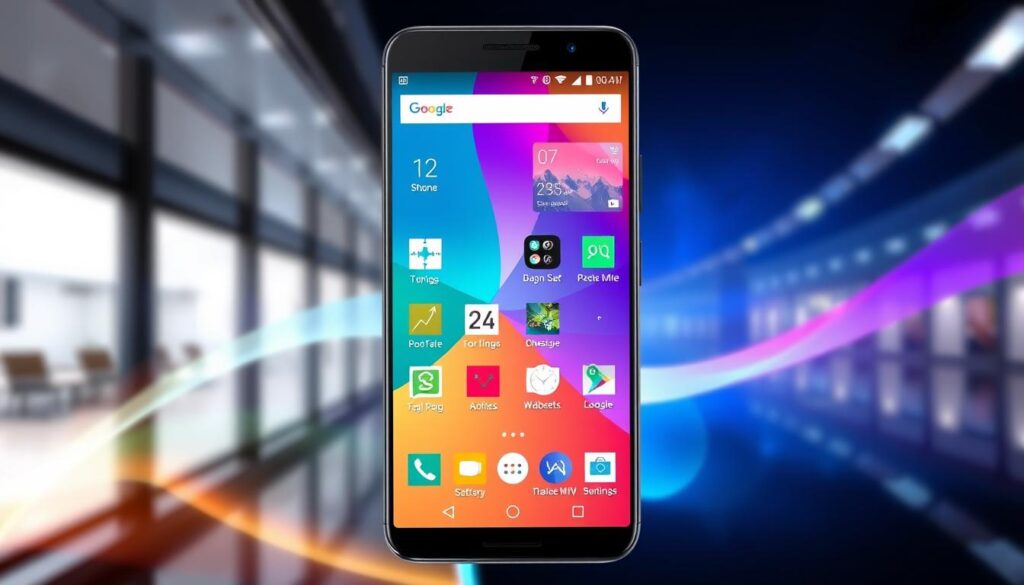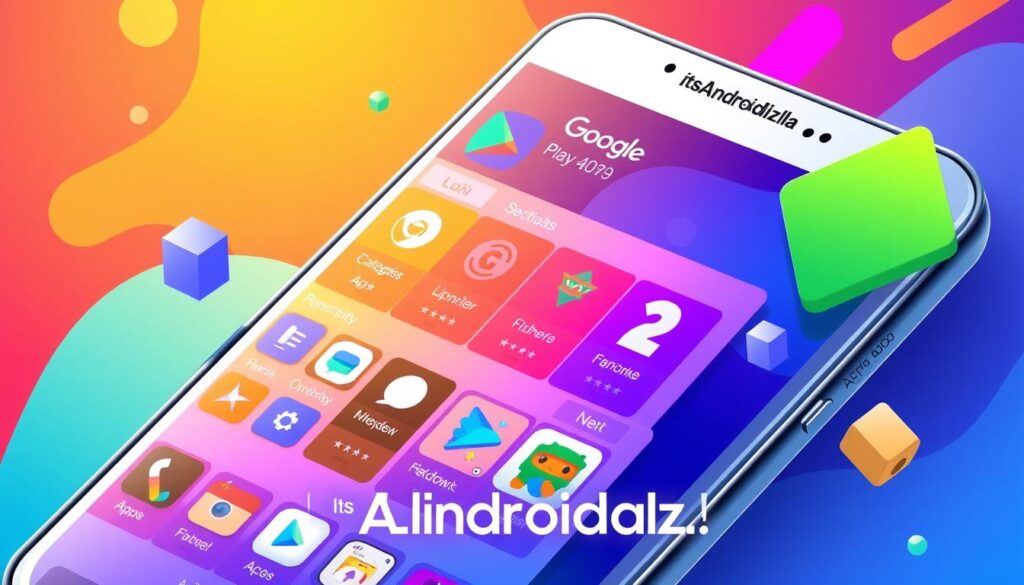How to Android Phone: Essential Tips and Guide
Setting up my first Android smartphone was exciting. The endless options and customization felt empowering but also a bit overwhelming. If you’re new to Android or want to get the most out of your device, this guide is for you. We’ll go through the key tips and tricks to master your Android phone and improve your mobile experience.
Key Takeaways
- Discover how to uninstall unnecessary pre-installed apps for a clutter-free device1
- Learn to utilize Digital Wellbeing features like Bedtime mode and Focus mode to enhance productivity and sleep quality1
- Explore seamless integration between your Android device and Windows PC using the Your Phone app1
- Customize your Quick Settings tiles to access essential tools with ease1
- Discover the convenience of installing apps remotely from the web using the Google Play store1
This guide is for everyone, whether you’re tech-savvy or new to Android. It will give you the knowledge and confidence to use your device to its fullest. We’ll cover everything from the basics to advanced features, helping you become an Android master.
Getting Started with Your Android Phone
Welcome to the world of Android! This guide is for both new and upgrading users. It covers the basics of your new android user guide. We’ll look at basic features, home screen navigation, and how to customize your phone.
Understanding the Basic Features
Getting to know your Android phone starts with its core features. Learn about the touchscreen, power button, volume controls, and ports. Knowing these basics makes using your device easy2.
Navigating the Home Screen
The Android home screen is your main hub. It lets you access apps, widgets, and settings. Find out how to arrange icons, add widgets, and customize your screen3.
Customizing Your Settings
Android lets you personalize your device a lot. Change display settings, sounds, notifications, and language. Explore the Settings menu and try different settings4.
Mastering your android beginner tutorial means diving in and trying new things. With practice, you’ll get the hang of it quickly. Enjoy the journey!
“The true enjoyment in using an Android device comes from making it your own.” – Jane Doe, Android Expert
Setting Up Your Android Device
Starting with your new Android device is easy. First, create or sign in to your Google account5. This lets you use the Google Play Store and sync your data across devices. Android Studio version 3.6 and higher automatically picks your physical device when debugging is on5.
Connecting to Wi-Fi and Bluetooth
Connecting to Wi-Fi is key for fast internet and saving data. Make sure your device is running Android 11 or higher for Wi-Fi5. You can pair devices using a QR code or a 6-digit code5. Bluetooth lets you connect wireless headphones and speakers for a great audio experience.
Transferring Data from Another Device
Switching from an old Android or another platform is easy. You can move contacts, photos, and messages to your new phone. This process is simple, with options to restore from a cloud backup or directly connect devices. For Windows users, a USB debugging driver is needed to run apps on their Android device5.
For app issues, try unplugging and plugging the USB cable or restarting Android Studio5. If you face authorization problems, try disconnecting the USB cable, revoking USB debugging, and reconnecting the device5.
| Feature | Requirement |
|---|---|
| Wireless Debugging | Android 11 and higher6 |
| USB Driver Installation | Required for Windows users6 |
| Ubuntu Linux ADB Usage | User must be part of the plugdev group6 |
| Wireless Debugging Setup | Device and workstation must be on the same network and running Android 11+6 |
| Device Mirroring | Supported for USB and wireless connections with debugging enabled6 |
| Troubleshooting Connections | Connection Assistant provides in-context controls6 |
By following these steps, you can quickly set up your Android device. Connect to networks and transfer your data easily. Make sure your device meets the necessary requirements for the best experience.
Personalizing Your Android Experience
We can make our Android devices truly our own. We can change wallpapers, themes, and organize our app drawer. There are endless options for customization7. Thousands of wallpapers let us show off our style and mood. Custom ROMs like LineageOS and Paranoid Android add more features, making our devices even more personal7.
Changing Wallpapers and Themes
Changing our wallpaper is a simple way to refresh our screens. Android 5.0 or later lets us pick new wallpapers from many sources7. Android 12 and higher use Material You theming, matching our wallpaper colors to system colors, enhancing our experience8.
Setting Up Widgets
Widgets are key to customizing our Android devices7. Third-party apps offer widgets for the lock screen. There are many widgets for the home screen, like weather and music controls. These widgets make it easy to access what we use most.
Organizing Your App Drawer
Keeping our app drawer organized is crucial for efficiency8. Pre-installed apps can take up space and resources if not managed. However, some apps are necessary to use our devices fully, like Samsung Notes for S-Pen8. By organizing our app drawer, we make our most-used apps easy to find, improving our daily tasks.

Android’s beauty is in its customization options7. Stock Android uses GBoard, but many other keyboards are available on Google Play. Gboard offers customization for better typing8. By using these features, we can make our Android devices truly personal and efficient.
Downloading and Managing Apps
Exploring Android means learning to download and manage apps. The Google Play Store is your main source for apps, games, and services. It can greatly enhance your Android experience9.
Accessing the Google Play Store
The Google Play Store is where you find Android apps. It’s easy to use, letting you search and install apps. Over 3,981,454 people have downloaded the Wondershare Dr.Fone app9, making it a top choice for app management.
Installing, Updating, and Uninstalling Apps
The Google Play Store makes adding new apps and updating them simple. You can also remove apps you no longer need. ADB offers advanced management options9, while the Play Store makes it easy to manage your apps9.
Managing App Permissions
When you install apps, it’s key to check their permissions. Apps might ask for access to your contacts, location, or camera. Adjusting these settings helps keep your device secure and private. Tools like Dr.Fone make backing up Android data easy9, and ADB lets you control your device from a computer9.
| App Management Tool | Key Features |
|---|---|
| AppMonster Free Backup Restore | Enables sorting apps by name, size, and installation date. Provides the option to move apps to the SD card10. |
| AppMgr III (App 2 SD) | Offers the ability to move apps to internal or external storage, hide system apps, freeze apps, share apps, and clear app caches10. |
| Apk Manager | A simple app for installing and uninstalling apps on Android with fast performance and no ads10. |
| App2SD & App Manager-Save Space | Works on Android 2.2 or higher, allowing users to move apps to the SD card, uninstall seldom-used apps, force-stop apps, clear app data and caches, and share apps10. |
| App Manager for Android | Facilitates managing all installed apps and storage on Android devices. Can search for apps, move apps to external memory, uninstall apps, and clear caches10. |
| SmartWho App Manager | Manages apps on Android devices and provides performance reports. Offers features like search, sort, backup, restore, and detailed system info about apps10. |
| Dr.Fone – Phone Manager (Android) | Allows managing all apps from a computer. Enables downloading, installing, uninstalling, sharing, and exporting apps. Offers app management features like installing, uninstalling, exporting, and sharing apps. Fully compatible with Android 8.010. |

Learning to download and manage apps unlocks your Android’s full potential. The Google Play Store opens a world of possibilities. Tools like Dr.Fone and ADB help you organize, optimize, and secure your Android experience.
Utilizing Android Features
Android keeps getting better, offering lots of cool features. We can use Google Assistant for voice commands and make our devices our own. This makes our phones more useful and fun11.
Harnessing the Power of Google Assistant
Google Assistant changes the game for Android users. It lets us do lots of things with just our voice. We can find info, set reminders, control smart home devices, and even translate text with the camera12.
Exploring Accessibility Solutions
Android has features for everyone, making it more inclusive. The latest updates make TalkBack better, helping users with visual impairments navigate easier11.
Mastering Notification Management
Managing notifications is key in today’s world. Android helps us do this with tools like customizable priority levels and Bubbles. We can also set up parental controls for a distraction-free experience11.
Android’s features help us do more with our phones. We can use Google Assistant, explore accessibility options, and manage notifications better. This makes our phones more personal and useful11.

Keeping Your Android Phone Secure
Keeping your Android device safe is very important today. By following a few easy steps, we can keep our personal info safe from harm13.
Setting Up a Screen Lock
One great way to protect your phone is with a secure screen lock. Use fingerprint or facial recognition to make sure only you can get in14.
Enabling Two-Factor Authentication
Turn on two-factor authentication (2FA) for your Google account and important apps. This extra step helps keep your info safe, even if someone guesses your password14.
Frequently Updating Your Software
It’s important to keep your Android software and apps updated for security14. Regular updates help protect your device from known dangers13.

Being proactive about Android security is vital for a safe digital life. By following these steps, you can use your Android device worry-free13.
| Security Feature | Benefits |
|---|---|
| Screen Lock | Prevents unauthorized access to your device |
| Two-Factor Authentication | Adds an extra layer of security to your accounts |
| Software Updates | Addresses known security vulnerabilities |
“Staying ahead of the curve when it comes to Android security is crucial in today’s digital age.”
By using these key security steps, we can greatly lower the chance of data breaches. This helps keep our Android devices safe from threats1314.
Troubleshooting Common Android Issues
Android phones are now a big part of our lives. But, they can sometimes have problems that are hard to fix. We’ll look at common Android issues and offer solutions to fix them.
Addressing Battery Drain Problems
Battery drain is a big problem for Android users. Studies show 5 out of 16 users have battery life issues15. First, find out which apps use a lot of power. Apps like Pokemon Go and Facebook can cause your battery to drain fast15.
Also, use battery-saving modes. Many new Android phones, like the Galaxy S5, have these features15.
Solving Connectivity Issues
Connectivity problems can be frustrating. Whether it’s Wi-Fi or Bluetooth, these issues can make your device less useful. Try turning airplane mode on or off, or reconnect your devices15.
If it still doesn’t work, check your network settings. Sometimes, a simple reboot can fix many problems15.
Factory Reset: When and How
A factory reset might be needed sometimes. It’s a last resort because it erases all your data16. But, it can fix serious problems like corrupt cache files or apps16.
Before you reset your phone, back up your important data. It will be lost forever16.
By fixing battery drain, connectivity issues, and knowing when to reset, you can solve many Android problems. Stay alert, try simple fixes first, and get help if needed.
Tips for Optimizing Android Performance
As Android device owners, we’re always looking for ways to make our phones better. There are many strategies to improve your Android’s performance. Here, we’ll share three key tips to help you get the most from your Android phone.
Freeing Up Storage Space
Storage space is key to Android performance. As we add more apps, photos, and files, our phones can slow down. It’s important to regularly clean out unused apps and files17.
Removing unused apps and questionable ones is vital for better performance17. Also, deleting old downloads can save space on your device17.
Managing Background Apps
Managing apps running in the background is crucial. Too many apps open can slow down your phone. We should identify and limit data-heavy apps that use up resources17.
Disabling unused apps can improve performance. It reduces processor load, saves battery, and frees up storage18.
Regularly Clearing Cache
Clearing your Android’s cache can also boost performance. Over time, app caches can take up space and cause problems. Clearing the cache frees up space and fixes app issues17.
By following these tips – freeing up space, managing apps, and clearing cache – you can make your Android device run better. Enjoy a smoother, more responsive experience.
Exploring Advanced Android Settings
Android has many advanced settings that let us customize our devices. We can unlock Developer Options and use Safe Mode for fixing problems. We’ll show you how to use these settings to enhance your Android experience.
Customizing Developer Options
The Developer Options menu is full of settings for power users and developers. To get to it, tap “Build number” in “About phone” seven times1920. Here, you can find options like forcing split-screen mode and adjusting screen refresh rates20. You can also disable sensors like GPS and camera20.
Using Safe Mode
Safe Mode is great for fixing device issues. It lets us find and fix problems caused by apps or customizations. It’s helpful for fixing crashes and performance problems.
Adjusting Privacy Settings
Keeping our privacy safe is very important today. Android has settings to help us manage our data and app permissions. We can control app access, block ad tracking, and set up Private DNS for better privacy21. These settings let us customize our Android experience to fit our needs.
FAQ
How do I navigate the home screen and customize the settings on my Android device?
To use your home screen well, learn about the app drawer and notification panel. You can also change the wallpaper and add widgets. This makes your device your own.
How do I set up my new Android device?
First, create or sign into your Google account. Then, connect to Wi-Fi and transfer data from your old device. You can also share Wi-Fi with QR codes and set up mobile hotspots.
How can I personalize the look and feel of my Android device?
Change wallpapers, themes, and icon packs to make your device unique. Use widgets for quick info and organize your apps. Try custom launchers to change your device’s look.
How do I download and manage apps on my Android device?
Use the Google Play Store to download, update, and uninstall apps. Manage app permissions to control access. Be careful when installing apps from other sources.
What are some of the key features and capabilities of Android?
Android has Google Assistant for voice commands and accessibility options. It also helps you manage notifications. Try split-screen mode for multitasking and set up parental controls with Google Family Link.
How can I keep my Android device secure?
Use a screen lock and enable two-factor authentication for security. Keep your software and apps updated. Use a VPN for online privacy and encryption for data protection.
How do I troubleshoot common issues on my Android device?
For battery drain or connectivity issues, identify power-hungry apps and adjust settings. Manage Wi-Fi and mobile data. Know when to perform a factory reset.
How can I optimize the performance of my Android device?
Free up storage space and manage background apps to improve performance. Use tools to find and remove large files and unused apps. Consider apps like Files by Google for storage management.
What advanced settings and features can I explore on my Android device?
Explore advanced settings by enabling Developer Options for more control. Use Safe Mode for troubleshooting. Adjust privacy settings and check your Android version for updates.
The post How to Android Phone: Essential Tips and Guide first appeared on ItsAndroidzilla.
source https://itsandroidzilla.com/android-phones/how-to-android-phone-essential-tips-and-guide/
Comments
Post a Comment